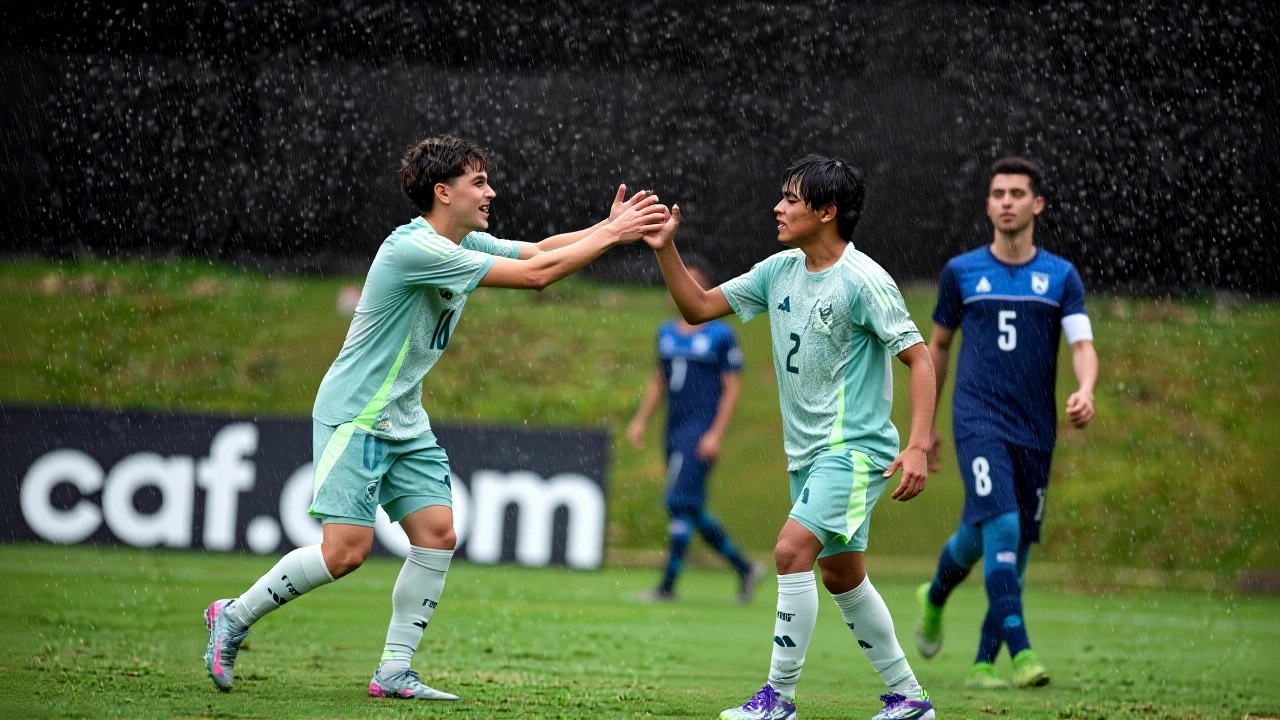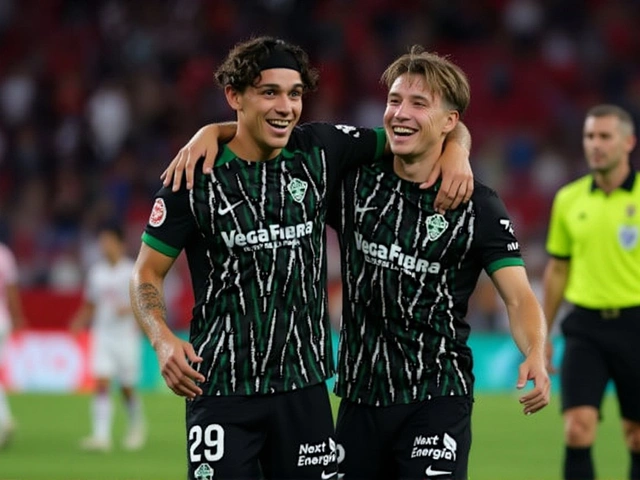On a humid Sunday afternoon in Alajuela, Costa Rica, Mexico didn’t just beat the United States — they erased any doubt about who’s building the future of Concacaf soccer. The 2025 Concacaf Boys' Under-15 Championship FCRF Federation Fields ended not with a whimper, but with a thunderclap: a 5-0 demolition of the defending champions, sealing Mexico’s record second U-15 Championship title and leaving the U.S. side shell-shocked. The final, played at 1:00 PM ET on August 10, 2025, wasn’t just a win — it was a statement.
A First-Half Masterclass
Four goals in seven minutes. That’s all it took for Mexico to turn a tense final into a coronation. Juan Carlos Martínez Jr. opened the scoring in the 16th minute with a half-volley that kissed the crossbar before nestling into the net. By the 23rd minute, he’d doubled his tally — this time from close range after a slick one-two with Paxton Ruffin, who himself had just buried a low drive into the bottom left corner in the 20th. Then came Davian Kimbrough, threading a finish through traffic at 22 minutes. The U.S. defense didn’t just lose the ball — they lost their bearings.
"It felt like we were playing against ghosts," said one U.S. assistant coach afterward, speaking on condition of anonymity. "They moved faster than we could think. Every pass found space. Every shot found the net. We were just trying to survive."
By halftime, the scoreboard read 4-0. The crowd — mostly Mexican families who’d flown in from Texas, California, and even as far as Monterrey — stood in stunned silence, then erupted. The fifth goal, a rocket from Lisandro Torres in the 65th minute, was almost an afterthought. He didn’t even celebrate. He just pointed to the bench, as if to say, "We told you so."
How Mexico Got Here
It wasn’t luck. Mexico had lost their group stage opener to Panama 3-2 — a shocker that sent ripples through the tournament. Juan Carlos Martínez Jr. and Davian Kimbrough scored in that game, but Panama’s Alfredo Maduro netted twice, and Alexander Tull added another. The loss dropped Mexico to second in Group A, behind Panama on goal differential. But here’s the twist: that defeat became their catalyst. Coaches scrapped the possession-heavy system and went full attack. They trained on high presses. They drilled finishing drills until 9 p.m. every night. By the semifinal, they were a different team.
They dismantled host nation Costa Rica 2-1 in the semis, with goals from Kimbrough and Ruffin. Meanwhile, the U.S. survived a nightmare against Panama — tied 2-2 after regulation, they won 6-5 on penalties. Niccolo Vafiades scored both U.S. goals, but the match was a mess of missed chances and last-ditch tackles. When the final draw was made, few expected Mexico to win by five. Most expected a tight game. No one predicted a massacre.

Third Place Drama: Costa Rica’s Grit
While Mexico celebrated, Costa Rica was writing its own underdog story. Facing Panama in the third-place match, they raced to a 3-0 lead in the first 18 minutes — goals from Ismael López, Sebastián Cantón, and Jefrey Urbina. Panama clawed back with Neir Marrugo and Emanuel Rodríguez, then tied it 3-3 when José Preciado headed home from a corner. Then came the red card: Kendall Alegría sent off in the 40th minute. Costa Rica played the final 50 minutes with 10 men. Still, they held firm. In the shootout, goalkeeper Sebastián Leiva stopped Panama’s third attempt. When Yordi Alfaro slotted home the winner, the Costa Rican bench collapsed into tears. It was their first podium finish since 2019.
Why This Matters
This isn’t just about youth trophies. It’s about pipeline. Mexico now has two U-15 titles — the first nation to do so — and has consistently produced players who transition into senior national team roles. The 2023 U.S. champions, by contrast, have seen just two players make senior appearances so far. Meanwhile, Mexico’s 2025 squad features at least six players already on the radar of top European academies, including Martínez Jr., whose two-goal final performance earned him Best Player of the Final honors.
"The U.S. still has the infrastructure," said former U.S. youth coach Luis Gómez. "But Mexico? They’ve got culture. They’ve got hunger. And right now, they’ve got the best kids."

What’s Next
The next Concacaf U-15 Championship is set for 2027, likely in Jamaica. But the real race begins now — in training pitches from Guadalajara to Miami. Mexico’s 2025 squad will be eligible for the 2029 U-17 World Cup. If they keep developing at this pace, they could be the favorites. The U.S. will need a full reset — coaching overhaul, scouting expansion, cultural shift — to catch up.
For now, Mexico’s players are already being asked about the senior team. "I want to wear the tricolor," Martínez Jr. told reporters after the match, smiling. "But first, I’m going to sleep for three days."
Frequently Asked Questions
How did Mexico recover after losing their group stage match to Panama?
After the 3-2 group stage loss to Panama, Mexico’s coaching staff completely restructured their attacking approach, shifting from a possession-based style to a high-press, fast-transition system. They drilled finishing for hours daily, and key players like Juan Carlos Martínez Jr. and Davian Kimbrough were given more freedom to roam. The result? Four goals in seven minutes in the final — a complete transformation from their earlier struggles.
Who was named the Best Player of the Final, and why?
Juan Carlos Martínez Jr. was named Best Player of the Final after scoring two goals — including the opener — and creating multiple scoring chances. His movement off the ball, composure under pressure, and clinical finishing in the first half overwhelmed the U.S. defense. Concacaf officials cited his leadership and technical dominance as decisive factors in the award.
What was the significance of Mexico’s 5-0 win over the defending champions?
The U.S. entered the tournament as defending 2023 champions and were considered favorites. A 5-0 loss — the largest margin in a Concacaf U-15 final since records began — exposed tactical gaps in U.S. youth development. It also marked Mexico’s second title, making them the first nation to win the tournament twice, signaling a shift in regional dominance.
How did Costa Rica manage to finish third despite playing with 10 men?
Costa Rica built a 3-0 lead in the first 18 minutes and held on through sheer grit after Kendall Alegría’s red card in the 40th minute. Goalkeeper Sebastián Leiva made a critical save in the penalty shootout, stopping Panama’s third attempt. With pressure mounting, Panama’s fourth kicker missed, and Yordi Alfaro converted the winner. Their resilience became a symbol of the tournament’s unpredictability.
Where were the matches played, and what was the tournament structure?
All League A matches were held at the FCRF Federation Fields in Alajuela, Costa Rica, with League B and C games spread across other regional venues. The tournament featured three divisions, with only League A teams competing for the championship. The final and third-place match were played on August 10, 2025, with kickoffs at 1:00 PM ET and 11:00 AM ET, respectively.
What does this result mean for future U.S. youth soccer programs?
The loss has triggered internal reviews within U.S. Soccer, with scouts and coaches acknowledging a gap in tactical discipline and finishing under pressure compared to Mexico’s system. The U.S. now faces pressure to invest more in regional academies, reduce over-coaching at youth levels, and prioritize game intelligence over physical dominance — areas where Mexico has excelled.




